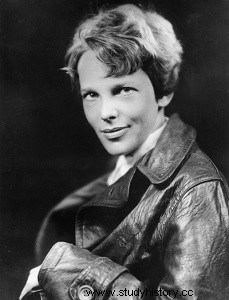
Amelia Earhart does not present an isolated case. Many women come to aviation with enthusiasm. It is for them an elegant sport, exhilarating despite its dangers. In 1929, the "powder puff derby" took place from California to Ohio, meaning the first women's air race, in which, of course, Amelia Earhart took part.
The seasoned pilots watch, indulgent and ironic, these ladies, androgynous clad in leather, pose for the photographers in front of their devices. They are wrong to smile. In less than ten years, some women will stand out and equal the best.
Already, in 1921, Adrienne Bolland had crossed the Andes; Léna Bernstein crossed the Mediterranean in 1929 and broke the women's duration record two years later. In 1935, Madeleine Charnaux won the altitude record for light aircraft (6,150 m). Maryse Hilsz, the "air athlete", a former parachutist, connects Istres to Saigon. In 1928, Maryse Bastié remained in flight for thirty-eight hours and, in 1936, flew over the South Atlantic, a feat achieved the previous year by New Zealander Joan Batten.
The most popular aviator in France is Hélène Boucher. She is pretty, feminine, and, after landing, she has a way of smilingly removing her white leather headband while shaking her chestnut hair that wins all hearts. She is the pupil of the great pilot Delmotte who, in 1935, on his Caudron, will beat the speed record for land plane with 505 km/h. In 1934, Hélène Boucher flew 1,000 meters at 444 km/h. She practices aerial acrobatics and competes against the German Vera von Bissing. On November 30, 1934, Hélène Boucher killed herself during training. We will mourn in her the incarnation of the "young girl of France".
In the United States and Great Britain, there are more pilots than in France. The Englishwoman Amy Johnson connects her country to Australia and will carry out other raids before becoming a transport pilot. There will also be Lady Bailey, Lady Heath and, compatriots of Amelia Earhart, Jacqueline Cochran — who climbed 10,000 meters and won the Bendix Trophy
Eleanor Smith, Ruth Nichols and many others again of various nationalities. One of them, Hanna Reitsch, will go down in history later. In Berlin invaded by the Russians, it will land near Hitler's bunker. For a while, you might even think she kidnapped the Führer.
Women also take part in major intercontinental races. Thus Amy Johnson or Miss Salomon in London-Le Cap, in 1936. Two years earlier, twenty competitors competed in London-Melbourne, in five stages, a competition won by Scott and Campbell Black on their Cornet De-Havilland, in covering the 18,185 km in two days twenty-two minutes thirty seconds.
Military aviation also performs not races — the aircraft must remain disciplined — but group flights. On the night of January 5 to 6, 1933, searchlights illuminated, on the black water of the Italian base of Orbetello, fourteen twin-engine double-hulled seaplanes. These are Savoia-Marchetti which, under the command of Marshal Italo Balbo, Minister of Air, will fly to South America.
Two of them, heavily loaded, are damaged at the start. The others, after a stopover in Portuguese Guinea, set off over the Atlantic. The weather is gloomy. Heavy tropical rains patter on the cabins. Browsers have a hard time keeping in touch. Finally, eleven seaplanes land in Natal and continue their journey to Rio.
The following year, France is in the spotlight. General Vuillemin led a "Black Cruise" of thirty aircraft in Africa, twenty-eight of which returned to Le Bourget.
In 1933, Balbo returned and his squadron reached Italy by crossing the North Atlantic. This success underlines the quality of the Italian wings, which had already been demonstrated by the performance of the seaplanes which distinguished themselves in the Schneider Cup against the British. In 1934, pilot Francesco Agello took off on his 3,100 hp MacchiCastoldi. When it returns, in the double sheaf of foam from its floats, the device has broken the world speed record:709 km/h. Five years later, the land plane takes its revenge. The German Fritz Wendel, on his 1000 hp Messerschmitt-109, exceeds 755 km/h.
